He’s certainly not the first to make such a remark, but when in a recent episode of his PBS show Mexico: One Plate at a Time, chef Rick Bayless commented that Mexican food may be the first “fusion cuisine” in the Americas, the concept resonated with me. The collision of cultures and culinary traditions that resulted from the European conquest of the Americas had as profound and delicious consequences for its Spanish, French and English protagonists as it had on the diets of its unwilling Native American and African antagonists. Indeed, and here I understand that I’m on sensitive ground, in cultural terms one might venture that one of the few short term benefits, that became a long term legacy, of this brutal period was the fabulous variety of new dishes that resulted from this coming together of New World, European and African ingredients and techniques.
Anthropologists and historians generally agree that apart from Brazil, the islands of the Caribbean are the most “Africanized” countries of the Americas because the extraordinarily harsh conditions, and consequential high slave mortality rate, in these places required that the plantation’s human capital be almost constantly replaced, continually refreshing African traditions. This sad history has allowed for the persistence of several West African cultural traditions, in syncretic religions like Haitian voodoo and Brazilian candomblé, as well as a variety of typical dishes, in the New World. Chief among the latter of these is the filling cassava mush known throughout much of Central and Western sub-Saharan Africa as fufu.
Most commonly served with a tomato or peanut based soup – which is sometimes garnished with seafood – fufu (fufuo, foufou, fougou) is believed to have originated in Twi-speaking regions of modern-day Ghana where the word foufouep (p is silent) means white and refers to the color of the cassava flour used in its preparation. When cooked with hot water and stirred to a similarly thick consistency as polenta or grits, and served on the side of a bowl of soup (or on a central platter), the diner takes a pinch of fufu, rolls it into an olive sized ball, makes an indentation with their thumb and uses it as an edible spoon for the soup.
The traditional shrimp and grits of the American South is, among many other variants, a direct descendant of fufu, where the American staple cornmeal has replaced cassava. In modern-day Cuba, one of the most traditional Afro-Cuban dishes, fufu de platano, has an even more direct bloodline to its African forebear in its use of that other West African starch, the green plantain.
Very similar to Cuban fufu is the joyously monikered mofongo of Puerto Rico – a dish that is so unbelievably delicious that it is even more fun to eat than it is to pronounce. Whereas fufu is often just mashed boiled plantains, mofongo (sometimes mofongu) is fried plantains that are then doused in a heavily-garlicked olive oil sauce while being pounded in a mortar. The mofongo is often then mixed with chopped up chicharrones (deep-fried pork belly cracklins), and shaped into a mound, before being dressed in an intensely savory tomato and shrimp-stock based gravy and garnished with sauted or fried shrimp.
More or less understood to be one of, if not the, national dishes of Puerto Rico, mofongo represents the creole (criolla) culture of that island in a truly unique way. The exotic tropical plantains native to Africa blending seamlessly with Caribbean-influenced sofrito used in the sauce and the typically Iberic flavors of olive oil and garlic into a colorful feast for the senses.
And a feast dish mofongo truly is. A Puerto Rican festival is said to be incomplete without mofongo, and this on an island where the perennial feast-time favorite, the long slow roasted pork dish called pernil is accompanied by both rice and beans and tostones. The competition in terms of delicious flavors being nothing short of extreme on that blessed island. Of course, we tend to wax lyrical about all the food we make here on WANF, but I want to stress that you have no idea just how amazing mofongo is, you just have to trust us and try it. It’s so rich, so intensely flavored, so texturally intriguing, and so quite unlike anything you’re likely to have eaten before. It’s a stunning combination that is as easy on the soul as it is invigorating for the intellect.
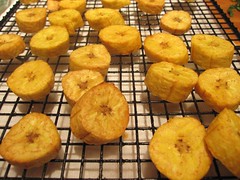 |
 |
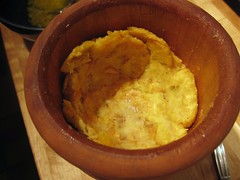 |
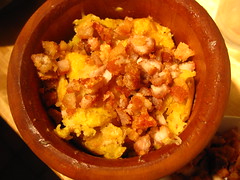 |
We first ate mofongo at one of a pair of fascinating restaurants in our Brooklyn neighborhood that have been serving the flavors of home to the area’s Caribbean population for more than 40 years. El Viejo Yayo (and El Viejo Yayo II) (meaning, roughly, the old man, or the grandfather), are the kinds of places – bright, harsh lighting, giant portions, patronized mostly by Latinos – that are a dying breed in our gentrified nabe, but can be relied upon for traditional island cuisine for these exact reasons. El Viejo Yayo serves a variety of mofongos, some as mains, others (almost unimaginably given their size) as side dishes, some with seafood, others with pork, and no matter how hard we try, it’s nearly impossible not to get one, in spite of the other wonderful offerings on their menu, including an outstanding soupy rice with seafood. [A propos of nothing, it’s always interested me that they also make a mean brandy alexander, just one of many retro cocktails that they, unlike trendier places, never stopped making.] Under the bright strip lights, perspiring gently as pork and carbohydrates flood our system, we’ll often look around at our fellow diners – elbows on tables, giant plates or bowls in front of them, talking loudly and energetically gesticulating – and remark how lucky we are to have all this delicious diversity on our doorstep.
It sounds rather trite to conclude any piece about food in this way, but out of the myriad sadnesses of a shameful past shrouded in human misery, suffering and squalor, has risen, in mofongo (amongst the New World’s many great dishes), a gastronomic legacy that is truly a cultural phenomenon to celebrate and be proud of. And, perhaps, therein lies one of enduring maxims of great national dishes, that they speak simultaneously of what is ugly and painful as well as beautiful and serene about a country’s character, while reflecting the shared joy and peace to be found in the simple pleasures of the table.
Ingredients:
- 4 green plantains
- 1/2lb fresh pork belly
- 1 cup good olive oil
- 12 cloves/1 head garlic, finely chopped and crushed, or pounded into a paste using a traditional Puerto Rican pilon.
- 2 cups vegetable oil for frying
- 1/2 cup white vinegar
- 3 pints water
- kosher salt
- 1lb large shrimp, shells removed
Recipe:
- Remove skin from plantains, and slice into 1 inch chunks
- Heat vegetable oil in a wok or saucepan to 350F/180C
- Gently place chopped plantains in oil and cook until they are nicely golden brown.
- Remove to a rack or kitchen paper to remove excess oil.
- Allow to cool.
- Take pork belly, and score fat side lightly in a cross-hatch. Simmer gently for 20 minutes in water mixed with white vinegar (this helps get your cracklins super crisp)
- Remove, drain and pat dry, before slicing into 1 inch wide strips.
- Cutting from the meat side towards the fat, make deep slices into meat so you have cubes of it that, when pork is bent, resemble a toothy grin (see picture above).
- Deep fry pork belly strips (chicharrones) until super crispy. About four minutes. Drain on cooling rack or kitchen paper and sprinkle lightly with salt, before placing in a 200F/100C oven for 20 minutes to maintain crispness.
- Now in a clean saute pan, warm olive oil and chopped garlic gently. Do not allow to color or cook.
- Season it lightly with salt and mash garlic into oil with the back of a wooden spoon.
- Remove from heat and reserve garlic oil/sauce.
- Remove chicharrones from oven, and chop into small pieces.
- In a pilon or other mortar and pestle, lightly smash cooled fried plantains so they all stick together but aren’t completely battered.
- Dress smashed plantains with garlic sauce and mix together with chicharron pieces, until all amalgamates into a ball that will stick together.
- Turn ball out of pilon onto a plate so you have a mound of mofongo.
- Quickly saute your shrimp (seasoning them however you like, we used a little hot pepper powder and some cumin)
- Arrange shrimp on plate with mofongo and dress with shrimp and tomato sauce (salsita de caldo de gambas) – see recipe below
- Enjoy with a brandy alexander or whatever island-themed cocktail you feel like.
Salsita de Caldo de Gambas (Shrimp Stock Sauce)
Ingredients
- 1 jar Goya sofrito (or 6-8oz of homemade Puerto Rican sofrito)
- shells of 1lb large shrimp (see above)
- 2 pints (1 liter) cold water
- 2tbsp fresh cilantro /coriander leaf, finely choppd
- 6 cloves garlic, roughly chopped or smashed
- 1/2 onion, chopped
- 1 6oz can Goya “Spanish-style” tomato sauce (Italian passata or pureed tomatoes will work too)
- juice of 1 lime
- 1/2 tsp ground cumin
- 1/2 tsp ground coriander
- Salt and pepper to taste
Recipe:
- In a saucepan, first saute shrimp shells in olive oil until they turn dark red.
- Add cold water and bring to a boil
- Reduce flame, cover and simmer gently for 1 hour
- Strain liquid (you should have 1 – 1 1/2 pints / 1/2 to 3/4 liter of stock) and reserve. Discard shells.
- In a large saute pan, heat olive oil and gently saute onions and garlic until soft.
- Add sofrito, cumin and ground coriander.
- After 4-5 minutes, stirring occasionally, add tomato sauce and 1 tbsp chopped fresh cilantro.
- Stir and after 2 minutes, add half shrimp stock. Stir again to combine.
- Increase heat to medium-high and allow sauce to reduce by about half. Taste.
- If it doesn’t taste decidedly shrimpy add the rest of your stock and repeat previous step.
- Taste again. Sauce should still be quite liquid.
- With a fine mesh sieve, strain sauce of solids and return to pan on medium heat.
- Reduce sauce again by about 1/3 but don’t let it get too thick. You want it to be viscous but still able to be poured.
- Taste again. Squeeze in lime juice and season with salt and pepper.
- Stir, sprinkle over remaining tablespoon of chopped cilantro, and after one final taste, it’s ready for the plate.
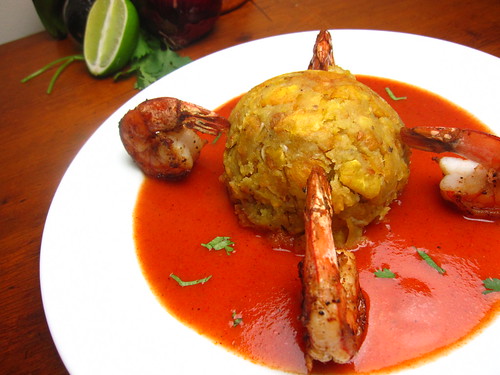

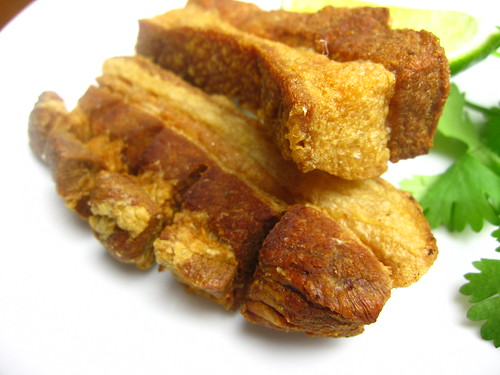
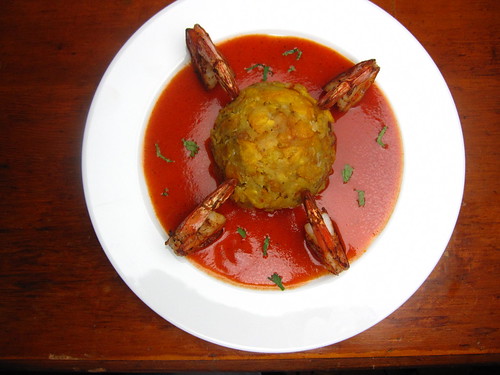
What a great post! I can’t wait to try it.
*Clap* *Clap* *Clap*
Excellent! I loved the introduction and how you explained how we have various influences in our dishes. We can’t deny the fact that most of our puertorrican cuisine is influenced by the slaves that were brought to the island.
Everyone here loves mofongo and is a must when we go and do some internal tourism. I love the one with shrimp, just like the one you made. I congratulate you once more because you really made another puertorrican dish like it is. No changes or variations.
Greetings from Puerto Rico!
I am coveting that massive wooden mortar and pestle of yours…
Great anthology of mofongo. I can attest to it being really delicious if any of your readers haven’t tried it. I didn’t know about soaking the pork in vinegar. I’ll have to try it sometime.
@Joan – we’ve read several different methods for extra crispy chicharrones – the other one, which we didn’t try, but will do eventually, is to add some baking soda to the water.
@Tina – It’s just too tempting not to say “that’s what she said”… sorry. (One of the pilones is actually another Brooklyn ground-score – found in a stoop-sale, another we bought back in ’07 in Genoa, Italy. Not only are they useful but they make great kitchen decorations too!)
Another highly educational post.
Your references to fufu remind me of the book “The Poisonwood Bible” where fufu was a staple food. The white people in the book wren’t too fond of it, but it wasn’t the most nutritiuos thing in the world to eat every day. They didn’t have chiccarones in their fufu either. That makes everything taste delicious!
Unlike its cousin, fufu (whose utility really is twofold: “scoop food” and “be filling”), this mofongo looks like it is worthy of eating in its own right! Plantains beat cassava any day. Thanks for the infotainment, too, as always.
Pleasures of the table, indeed!
Sounds incredible, and the sauce is gorgeous!
LL
WOW, wonder where can I get that mortar and pestle here 🙁 definitely delicious sounding food, would definitely try to make “Mofongo”. Thank you so much for sharing the recipe.
God I love you guys! I learn something every time I come here. I first ordered fufu out of curiosity of the name, but looooove the stuff, esp with shrimp. I’ve been wanting to try mofongo since I saw it show up on Bourdain’s show a while back.
Just tried mofongo for the first time at a restaurant…YUMMMMM!!! I am going to try to make it home next time with this recipe so thank you!
Being half Nigerian I love this post. There is a connection between Nigeria and Brazil. This dish looks awesome and never Mofongo before.
So glad you made the direct connection to Africa. Even the name Mofongo comes from Kikongo roots. Other famous dishes like mondongo and malanga also have roots in African language. Sadly we often tend to reinforce old colonial attitudes and value systems steeped in eurocentricity. Most of our best foods, music and some fantastic language comes from our African roots. No more shame. Let’s not relegate these foods and practices which kept enslaved Africans and their Descendants alive for centuries! Thank you for the article.
I meant to add – no more shame lets not relegate the foods and cultural/religious practices which kept enslaves Africans and their descendants to the back burner!